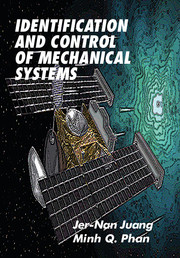Book contents
- Frontmatter
- Contents
- Preface
- 1 Ordinary Differential Equations
- 2 Elementary Matrix Algebra
- 3 Modeling Techniques
- 4 Finite-Element Method
- 5 Response of Dynamic Systems
- 6 Virtual Passive Controllers
- 7 State–Space Models
- 8 State-Feedback Control
- 9 Dynamic Feedback Controller
- 10 System Identification
- 11 Predictive Control
- Index
7 - State–Space Models
Published online by Cambridge University Press: 02 September 2009
- Frontmatter
- Contents
- Preface
- 1 Ordinary Differential Equations
- 2 Elementary Matrix Algebra
- 3 Modeling Techniques
- 4 Finite-Element Method
- 5 Response of Dynamic Systems
- 6 Virtual Passive Controllers
- 7 State–Space Models
- 8 State-Feedback Control
- 9 Dynamic Feedback Controller
- 10 System Identification
- 11 Predictive Control
- Index
Summary
Introduction
This chapter shows the reader how to rewrite the second-order equations of motion for a general multiple-degree-of-freedom system into the form of a first-order matrix differential equation. What we have learned from Chap. 1 about the mathematics of a first-order matrix differential equation then applies. The first-order matrix differential equation is known as the state–space model, which is a fundamental equation on which modern control theory is based.
In this chapter, we will also study a sampled-data (or discrete-time) representation of the continuous-time state–space model. Assuming a constant input at each sampling interval, it is possible to represent the continuous-time state–space model that is in the form of a first-order matrix differential equation by a discrete-time first-order matrix difference equation. At the sampling points, the corresponding discrete-time state–space model describes exactly the continuous-system with a constant input at each sampling interval without any kind of approximation (Ref. [1–3]). The corresponding discrete-time model is also of the first order. As a result, control methods that are originally developed in the continuous-time domain can be converted almost trivially to the discrete-time domain for digital control implementation (Ref. [2]). Digital control is flexible in that changing a control strategy amounts to writing a different program (software) rather than constructing a different analog control circuitry (hardware). For the same reason, different signal processing techniques such as filtering, identification (Ref. [1]), etc., can be incorporated much more conveniently into the discrete-time digital format.
Information
- Type
- Chapter
- Information
- Identification and Control of Mechanical Systems , pp. 164 - 183Publisher: Cambridge University PressPrint publication year: 2001
